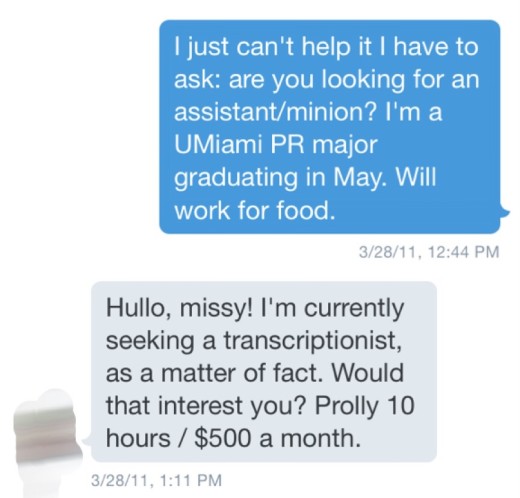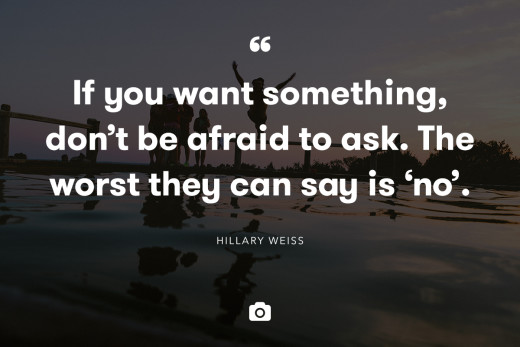
“We’re letting you go.”
The year was 2011. I was fresh out of college, and with the ink barely dry on my Public Relations degree, I was losing my first job post-graduation.
“We’re sorry, the money’s just not there anymore.” My soon-to-be-former boss leaned back in her chair to peer at me.
Oh God, did I look panicked? I felt like I was panicking. “You’ve still got your freelance thing though, right?”
It was true. Kinda. I’d been moonlighting as an assistant copywriter and transcriptionist for about six months. I loved the work. I loved my clients. But until that point I’d never taken it seriously.
I knew essentially zero about business. I was 22, could barely keep my apartment clean and spent too much money on concerts. Not exactly ‘entrepreneurial material’.
Did I know anyone who’d gone full-freelance and stayed afloat? No. And all my self-employment heroes had at least five years on me. As for agency jobs, ‘few and f*cking far between’ was putting it gently.
It was sink or swim. But really: what choice did I have?
So, in that fairly unremarkable moment, my journey began.
Fast forward four years and I’ve managed to grow my by-night venture into a full-scale freelance copywriting career.
To date, I’ve worked with close to 200 brands across the planet and am on track to hit my first six-figure year in 2016. And it all started on that almost-earth-shattering afternoon.
A good number of people who hear my story immediately want to know how I manage to make a living (and a name) for myself doing creative work with practically zero business knowledge.
The short answer is this: my first year, I mostly flew by the seat of my pants. But I wasn’t soaring through a vacuum. I picked up and applied strategic pointers from pros I watched and worked for.
These tactics helped me push through the doubt and fear that I couldn’t hack it (an obstacle every freelancer and entrepreneur hits), keep up my momentum when things got dark and think bigger when things got brighter.
They’re very human, non-skeezy success guidelines I still use in my business today.
While they might seem simple at the outset, they’ll serve you well in the continuing adventure of your business. So without anything further, here are my eight rules for making it as a freelance creative (even if you know jack about ‘real business’):
Rule #1: Be all about the proactive ask
Full disclosure: I got my whole career started with a Twitter DM to someone I admired. This one, specifically:

Too many entrepreneurs shy away from reaching out and asking for what they need.
Make friendly, specific requests of the heroes or colleagues you admire. Tell them what you like about them and ask what their skill development/support/book recommendations might be. If you’re feeling ballsy, you can also offer your services to support them and get closer to their work.
This extends into your client search, too. Social media is your best friend for this. I picked up more than one gig just searching for ‘copywriter wanted’ on Twitter and Facebook and firing off an email. Finding clients through these avenues also offers the extra bonus of direct contact (which means you’re more than a portfolio floating in cyberspace).
If you want something, don’t be scared to ask. The worst they can say is ‘no’.
Rule #2: Awesome client experiences are everything
Every client I’ve ever worked with has at least one horror story about some freelance contractor running off with their money, disappearing, or worse. So the good news is: if you’re hitting deadlines and not robbing people, you’re already ahead of the curve. But a little extra goes a long way.
Answer your emails on time. Be friendly. Ask your clients about themselves. Find out their favorite music genre, or city, or swap stories about family. Take obsessive notes. Listen closely and deliver what they want.
This goes beyond just being cheerful on the phone. That ‘awesome experience’ factor has been the driving force behind every change I’ve made to my business model (from project-based, to intensive-style, to long-term packages).
So, when making any shifts to your methods, or developing any program for your people, always ask: how do my clients like to work? What do they value about their time with me and how can I create more of that? What’s ahead for them? How can I create offerings they’ll go nuts for?
But the key to sustaining great experiences is simple: treat clients the way you’d want to be treated.
Rule #3: Give people incentives to spread the good word
Make it in your clients’ best interest to put your name out there.
There are tons of ways you can sweeten the deal for new and existing clients. Offer your first service free to new folks, or give a bonus kickback percentages on services for every fresh face an existing client brings your way (say, a 20 percent discount, or $150 cash credit per new client on their next project).
Word of mouth promotion is the best kind of advertising there is. And if you do it right, it doesn’t have to cost you a penny. There’s no better ROI.
Rule #4: Diversify your skills
When I started, I was faced with a ton of projects I had zero experience with. Video scripts, sales content, product descriptions, ebooks… I had two choices in those circumstances: take on the unknown deliverable, or let the job go.
I wasn’t in a place to be turning away clients, and I knew these were skills that would make me a better writer. So I said yes.
Now, you don’t have to follow that model necessarily. But the greater your range, the greater your potential reach. I encourage you to boldly take on new projects you’re a little less familiar with. Just remember to be open with your clients.
Don’t hesitate to offer your clients a kickback. Do these new projects for a ‘learning rate’, or just get their thumbs up to try your hand. Then hit the books and make it happen!

Rule #5: Master your intake approach
Welcoming a new client into your world should be more than just a signed contract and a paid invoice.
You need to help them get clear about what they need, what you need and what both of you expect from one another. This will make them feel safe and supported, while making the way you want to work completely clear.
Have a form ready, asking them key questions about their vision and goals. Spell out every step of the creative collaboration journey for them: how to give feedback, when to expect drafts, when to have them back to you, etc.
A great intake process makes you look highly professional, equip you with a ton of essential info and save you a boatload of email-answering time. What’s not to love?
Rule #6: Value your community
Connection is an integral part of your entrepreneurial experience. With a great group of people supporting you — in social media communities and forums, mastermind groups and the real world — there’s nothing you can’t do. Reach out and find them.
Industry allies can introduce you to new clients, help you re-think your business and support you through the good and less-good days. They’re your window into opportunities to increase your visibility and step up your brand.
Besides, entrepreneurs are some of the most generous, phenomenally brilliant people out there. Get to know as many of them as you can.
Don’t be shy to give and receive. You won’t regret it.
Rule #7: Be visible
Yeah, you heard me. Get out there and get seen.
Old-fashioned, in-the-flesh networking is an art worth preserving. So find meetups in your area. Attend conferences. Find local industry folks on social media. The more people you meet and trade cards with and grab coffee with, the more seeds you’ve sown.
Do guest blog posts and articles if you have the time. Welcome offers to be a featured expert in programs or educational materials. I can’t begin to tell you how many opportunities have come my way because I wrote an article for a client’s blog, or appeared on their podcast, or lent a quick 20-minute training audio to their digital programs.
It’s fun, costs you little and is a brand of generosity that almost always comes back to you. Do it.
And, last, but perhaps most importantly:
Rule #8: Be patient and gentle with yourself
Things will change for you, day to day and year to year. There’s going to be a lot of trial and error, dizzying highs and sobering lows—but if you’re dedicated to the work you love creating you can and will make it happen.
While the rules above don’t guarantee success, they’ll make your journey clearer; like trusty lanterns on the sometimes-foggy road of self-employment. They’ll help you spread the word to potential clients without feeling sleazy, become great to collaborate with and create a wireframe for the unique experience of working with you.
No excuses. Go get ‘em.
Get the TNW newsletter
Get the most important tech news in your inbox each week.





